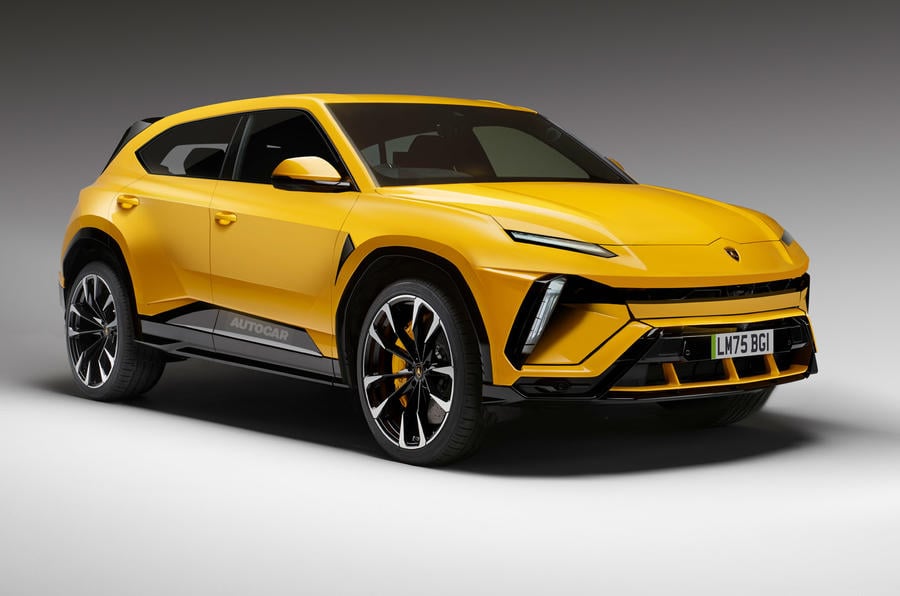Lamborghini Electric GT crossover due in 2028 as a higher-riding evolution of the much-missed Estoque.
The first fully electric Lamborghini will be an all-new, radically styled 2+2 crossover arriving in 2028, and the Sant’Agata firm has revealed that it will preview the EV with a concept at Monterey Car Week next week.
This new concept will be the latest in a long line of future-looking show cars revealed by Lamborghini over the past 60 years.
It said: “Ever since its foundation in 1963, Automobili Lamborghini has made one-off models that signal the technical and stylistic direction the company will take in the immediate future. These are design or technical prototypes or experimentation with new concepts to help develop the Lamborghinis to come. In the 1960s, these one-offs were very often show cars bound for motor show parades.
“In more recent years, the designation changed from “one-off” to a category created specially by Lamborghini: “few-offs”, essentially a limited run of cars for the most loyal customers that pre-empt or enhance the most advanced technical solutions that will be used on production cars in later years. The same formula will be repeated in just a few days at Monterey Car Week in California, where Automobili Lamborghini will present the prototype of its first 100% electric car.”
Lamborghini gave no further details of what to expect from the concept but, as already reported by Automotive Daily Network partner Autocar, the company’s long-awaited fourth model line will take the firm of a high-riding, four-seat super-GT. It will be followed in 2029 by an electric successor to the Urus to give Lamborghini a four-strong line-up of electrified sports cars by the end of the decade; the Aventador-replacing Revuelto PHEV has now entered production in Sant’Agata, and the hybrid successor to the Huracán will be launched towards the end of next year.
The new 2+2 crossover is expected to draw light inspiration from the Lamborghini Estoque saloon concept, which was revealed in 2008 but never made production.
Lamborghini insiders suggested at the time that there was significant customer support for the car but that the cost of its development versus projected sales meant it didn’t make it from the Volkswagen Group’s prioritisation list to production. Funds were instead focused on a rapid development of its SUV offerings – including the ultra-successful Urus, of which 5367 examples were sold last year.
However, instead of being designed around a four-door saloon silhouette, the EV will sit higher, as a result of its floor-mounted battery pack, and to have significantly more dramatic styling to highlight that its powertrain differentiates it from other Lamborghinis.
While it is loosely being described as a crossover, CEO Stefan Winkelmann highlighted that the different packaging requirements of an EV “open up interesting avenues” in terms of its eventual design.
Lamborghini design boss Mitja Borkert recently asserted to Autocar that all future vehicles from the firm will still “look like spaceships”.
The 2+2 might also be a two-door; the popularity of super-luxury four-door saloons has waned in recent years. Market analyst Jato Dynamics’ data suggests that they have fallen from 21.6% of the sector’s sales mix in 2010 to just 9.1% in 2022.
Winkelmann confirmed that the strategy to launch the 2+2 and then the new Lamborghini Urus was a result of family-oriented customers being more open to going electric.
“For now, electrification suits these kinds of vehicles,” he said. “That will develop, but we must plan for what we know will work best today. There are definitions that I think no electric car in our sector has yet resolved sufficiently: not just acceleration and handling behaviour but also responsiveness, braking feel and multiple acceleration protocols. These are unproven in high-performance EVs and things we must spend the next years working out.”
The revelations from Autocar’s exclusive interview provide the first details to support Lamborghini’s stated electrification plan, announced in 2021.
Called Direzione Cor Tauri, referring prosaically to the Latin name for a bull’s heart and the brightest star of the constellation of Taurus, the plan lays out a three-step strategy towards electrification.
The initial stage, a celebration of pure-ICE specials, concluded last year, ahead of the launch of Lamborghini’s first plug-in hybrid, the Revuelto, which is now sold out until 2026.
By the end of 2024, all three of Lamborghini’s models – the Aventador, Huracán and Urus – will be sold as plug-in hybrids.
That will allow the company to record official CO2 outputs at half of its 2022 levels by 2025, the pair of EVs then providing a further significant reduction.
“What’s clear is that customer perceptions have shifted,” said Winkelmann.
“They are aware of the legislation and interested in the technology so long as it marries sustainability with enhanced performance from what has gone before.
“That’s why [Lamborghini’s] hybridisation phase is coming first: that has been digested and accepted by the customer base. Even the majority of petrolheads say that they have accepted our vision on that. And in turn, that opens the door for a new breed of customer to look at full electrification.”




